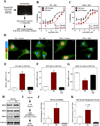BET acetyl-lysine binding proteins control pathological cardiac hypertrophy
- PMID: 23939492
- PMCID: PMC4089995
- DOI: 10.1016/j.yjmcc.2013.07.017
BET acetyl-lysine binding proteins control pathological cardiac hypertrophy
Abstract
Cardiac hypertrophy is an independent predictor of adverse outcomes in patients with heart failure, and thus represents an attractive target for novel therapeutic intervention. JQ1, a small molecule inhibitor of bromodomain and extraterminal (BET) acetyl-lysine reader proteins, was identified in a high throughput screen designed to discover novel small molecule regulators of cardiomyocyte hypertrophy. JQ1 dose-dependently blocked agonist-dependent hypertrophy of cultured neonatal rat ventricular myocytes (NRVMs) and reversed the prototypical gene program associated with pathological cardiac hypertrophy. JQ1 also blocked left ventricular hypertrophy (LVH) and improved cardiac function in adult mice subjected to transverse aortic constriction (TAC). The BET family consists of BRD2, BRD3, BRD4 and BRDT. BRD4 protein expression was increased during cardiac hypertrophy, and hypertrophic stimuli promoted recruitment of BRD4 to the transcriptional start site (TSS) of the gene encoding atrial natriuretic factor (ANF). Binding of BRD4 to the ANF TSS was associated with increased phosphorylation of local RNA polymerase II. These findings define a novel function for BET proteins as signal-responsive regulators of cardiac hypertrophy, and suggest that small molecule inhibitors of these epigenetic reader proteins have potential as therapeutics for heart failure.
Keywords: Acetyl-lysine; BET protein; Cardiac hypertrophy.
© 2013.
Conflict of interest statement
No conflicts of interest exist for the authors.
Figures


References
-
- Lloyd-Jones D, Adams R, Carnethon M, de SG, Ferguson TB, Flegal K, et al. Heart disease and stroke statistics--2009 update: a report from the American Heart Association Statistics Committee and Stroke Statistics Subcommittee. Circulation. 2009;119:e21–e181. - PubMed
-
- Devereux RB, Wachtell K, Gerdts E, Boman K, Nieminen MS, Papademetriou V, et al. Prognostic significance of left ventricular mass change during treatment of hypertension. JAMA. 2004;292:2350–2356. - PubMed
-
- Gardin JM, Lauer MS. Left ventricular hypertrophy: the next treatable, silent killer? JAMA. 2004;292:2396–2398. - PubMed
-
- Hill JA, Olson EN. Cardiac plasticity. N Engl J Med. 2008;358:1370–1380. - PubMed
Publication types
MeSH terms
Substances
Grants and funding
LinkOut - more resources
Full Text Sources
Other Literature Sources
Miscellaneous

